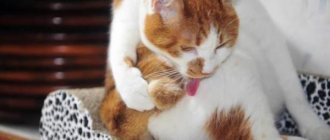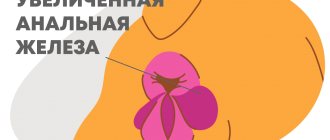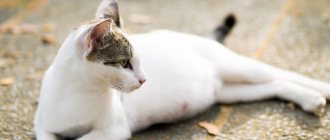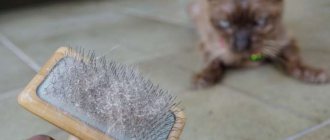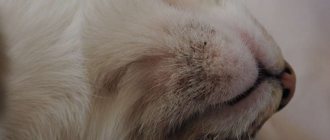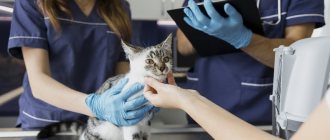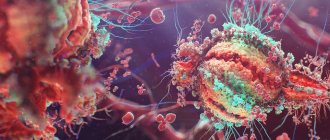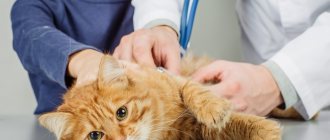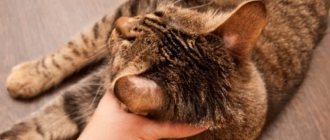Domestic cats often experience inflammation of the paraanal glands. However, many owners do not even know that their pet has them and what functions these glands perform. So that you can help your cat in a timely manner and prevent consequences dangerous to its health, see the most useful information about the signs and causes of inflammation of the paraanal glands.
Read in this article:
What are paraanal glands? Common causes of inflammation Signs of inflammation and abscess Treatment: main stages and methods
- Cleaning
- Washing
- Removal
Recovery after treatment Prevention of inflammation of the paraanal glands
What are paraanal glands?
Anal (paraanal) glands are paired glands located at the anus. They look like small “bags” and secrete a secretion that performs various functions. One of them is recognizing the opposite sex and attracting them for further mating.
Other functions performed by the paraanal glands:
- protection from enemies (scaring away),
- marking the occupied territory,
- maintaining metabolism in the body,
- attracting partners.
During inflammatory processes, the functions of the glands are disrupted. Because of this, the pet experiences serious discomfort. In advanced cases (for example, with the development of an abscess), this problem can lead to serious and irreversible consequences. However, it is possible to avoid them if you know all the most important things about the causes and signs of inflammation.
Diagnostic methods
The diagnosis is made based on a visual examination of the glands and an assessment of the amount and characteristics of the secretion. The doctor uses a napkin to squeeze the glands and examine the released secretion. Based on its consistency, color, and quantity, it determines the stage of the disease.
According to indications, laboratory tests of the microflora of the secretion are carried out - culture is done for pathogenic pathogens. The results of the analysis help to select antibacterial drugs to which microorganisms are sensitive. Laboratory studies are also used to evaluate the effectiveness of therapy.
Common Causes of Inflammation
Inflammation or abscess of the paraanal glands often develops with trauma and mechanical damage to this area (for example, falls from a great height). This leads to dysfunction of the glands, disruption of the outflow of secretions and its subsequent accumulation. All this provokes the development of an inflammatory process involving pathogenic microflora.
Most often, long-haired cats living in apartments face the problem of inflammation of the paraanal glands. This is due to the fact that they lose the natural ability to cleanse the anal sacs (due to the absence of potential enemies and the need to defend themselves from them).
Common causes of inflammation of the paraanal glands:
- dysbacteriosis (for example, due to prolonged use of antibiotic drugs by the pet),
- helminthic infestations,
- eating small bones
- feeding mass market liquid food,
- lack of physical activity,
- injuries to the anus and anal area,
- disorders of the gastrointestinal tract, accompanied by frequent constipation.
Older cats are more prone to inflammation and abscess of the anal glands. One of the factors that can affect the development of the inflammatory process is that the pet’s gland channels are too narrow from birth. Veterinarians include cat pregnancy and excess weight (obesity) as additional provoking factors.
Without timely veterinary care, the animal will develop complications. The inflammatory process can quickly develop into an abscess (purulent inflammation), which poses a threat not only to the health, but also to the life of your pet. That is why, when the first signs of a problem appear, you need to contact a veterinary clinic in Moscow as soon as possible.
Consequences and possible complications
If help is not provided in a timely manner, inflammation from the subcaudal region can spread to deeper tissues. Pockets and adhesions develop. Contamination with microflora allows inflammation to become chronic, with regular acute exacerbations.
The disease is especially dangerous for old animals and those whose immune status is low. If the body cannot cope with the infection on its own, microorganisms are absorbed into the bloodstream, spread throughout the body and cause sepsis.
Signs of inflammation and abscess
Signs of inflammation develop gradually. They are accompanied by an increasing painful symptom. Due to pain and itching, the cat constantly licks the area of inflammation (tail and anus). The pet stops playing, spends time in solitude, practically does not move and constantly lies down. However, this is not the only symptom.
Other signs characteristic of inflammation of the paraanal glands:
- weakness,
- apathy,
- unpleasant specific odor from the pet’s body (does not disappear after washing),
- poor appetite (in later stages – refusal to eat),
- painful bowel movement,
- discharge from the anal glands.
With an abscess, this condition is accompanied by purulent or bloody discharge. In especially severe cases, body temperature rises. When stroking the affected area, the pet shows aggression and anxiety. Defecation is accompanied by severe pain, so the cat meows loudly on the tray.
Taking care of our pets
Every cat owner should have a clear idea of what diseases he may encounter in his animal. often advise washing cats' anal openings with soap and water. This procedure has a stimulating effect on the anal glands, helping them to cleanse themselves. We also appeal to attentive owners who take their pet for examination at an animal care center - remind the veterinarian about a routine examination of the secretion sacs.
Since the animal experiences pain and shows aggression when performing manual manipulations to remove secretions, it is recommended to contact a specialist. At the Ya-Vet help center, experienced doctors will show you professional, fast help at low prices for your pet. We show love to animals by keeping them healthy!
Treatment: main stages and methods
Treatment of inflammation or abscess of the paraanal glands should only be carried out by an experienced veterinarian in Moscow. We strongly do not recommend trying to help your pet at home. This will only worsen an already difficult situation.
The first step in treating inflammation is diagnosing the animal's condition. The veterinarian examines the affected area, interviews the owner (about the severity of symptoms, the degree of their manifestation, etc.), after which he assesses the cat’s condition and prescribes treatment.
Cleaning
If you consult a doctor in a timely manner (at the first stage of the inflammatory process), then treatment will be limited to cleaning the paraanal glands. This procedure does not require special conditions, so it can be performed in the clinic or at home, but only by a professional veterinarian.
Before cleansing the glands of accumulated secretion and secretion, it is necessary to palpate them. This will allow you to determine the consistency of the contents and select a cleaning method. If the secretion is liquid, then the external method is used, if it is dense, the method of rectal sanitation is used.
After cleaning is completed, the affected area is thoroughly treated using an antiseptic solution. To prevent further inflammation (preventive measure), an anti-inflammatory suppository is inserted inside.
Washing
Unlike external cleaning, washing the paraanal glands cannot be done at home. It is carried out only in a veterinary clinic, since it is prescribed in difficult situations (for example, when a fistula forms).
Before washing the abscess, the glands are cleared of accumulated secretions, then an injection is given with local anesthesia. Next, the specialist injects an antiseptic solution into the anus using a catheter (an alternative is a syringe without a needle).
Washing is carried out not once, but several times. This is necessary so that the liquid flowing back (antiseptic solution) becomes completely transparent. This condition indicates that there is no secretion or purulent discharge left.
After washing, the pet is given an anti-inflammatory suppository, and the damaged area is carefully treated with antiseptic ointment. If the cat's condition is of concern, the specialist will prescribe a course of antibiotics.
Removal
Unfortunately, washing does not always give a positive result. In particularly severe situations (for example, with a developed abscess), the veterinarian resorts to an extreme method of treatment - surgical removal of the paraanal glands.
The surgery is performed using general anesthesia. The surgeon makes two incisions in the area where the glands are located, and then removes them along with the ducts. Then he puts stitches and treats with an antiseptic solution.
After surgery, your cat will need home care. In order for it to fully recover, it is necessary to regularly treat the area with regenerating agents (solutions, ointments), give vitamins and antibiotics for 7-10 days.
What happens if you do not contact a veterinarian in time if there is a pathology?
Don't think that the problem will solve itself. As we have already said, the accumulated secretion in the anal sacs becomes an excellent breeding ground for the proliferation of pathogenic bacteria. If clogged anal glands are not cleared, your pet will require lengthy and complex treatment.
Signs of a worsening situation are:
- pain experienced by the pet during bowel movements (he may whine, grunt, etc.);
- hair loss;
- redness of the tissues near the anus;
- wet areas;
- presence of fistulas;
- swelling in the anal area;
- presence of irritation, etc.
In such cases, the animal needs urgent help from a specialist. You cannot clean the anal glands yourself!
Recovery after treatment
After cleaning, rinsing or removing the anal glands, your cat requires special care. This will allow her body to recover faster and avoid unwanted consequences. The first thing that is necessary is to ensure the pet's comfort. Set up a bed for him in a warm place without drafts or blowing.
Maintain a therapeutic diet for 10-14 days. Eliminate solid food completely and provide constant access to fresh drinking water. Avoid excess carbohydrates in your animal's diet. It must be completely balanced so that the cat quickly recovers from a severe inflammatory process.
Diet and feeding of a cat
A predatory and carnivorous animal must feed accordingly. When thinking through a cat’s diet, you need to remember that the main place in it should be occupied by the following ingredients:
- meat and offal;
- fish and fish products;
- dairy products;
- eggs.
Food from the listed products should be included in the diet every day. You should not allow your diet to be overfilled with carbohydrates. This contributes to changes in the composition of the intestinal microflora and suppression of the immune system.
Prevention of inflammation of the paraanal glands
Inflammation and abscess of the paraanal glands are a serious blow to your cat's health. However, it is possible to avoid it. The main thing is to follow simple recommendations for prevention from experienced veterinarians.
Adviсe:
- Your pet should lead an active lifestyle (in accordance with its age). If you don't have much time, special toys and exercise equipment for cats will help with this.
- If your animal's anal glands are often clogged, consult a specialist and discuss the issue of removing them.
- Try to avoid cheap liquid food and do not give your pet small bones, as well as foods that can cause gastrointestinal injury.
- At the first signs of inflammation, consult a doctor. Don't forget about regular preventive examinations.
- Carry out anthelmintic treatment once every 6-12 months. This completely eliminates the possibility of developing parasitic diseases.
Inflammation or abscess of the paraanal glands is dangerous to the health and life of the cat. A seemingly insignificant problem can lead to dangerous consequences, including death. That is why we strongly recommend that you follow preventive measures, and if the first signs of inflammation appear, contact your veterinarian immediately!
Drugs used
To successfully treat an animal, the use of any one remedy is not enough. Therapy must be comprehensive. Medicines should be used both internally, to suppress microflora, and locally.
Ointments
Ointments and liniments have a fatty base, which contributes to:
- rapid absorption of the active principle;
- preventing drying out of serous and mucous membranes;
- softening of tissues, as well as dried “crusts” and their rejection.
If there are no wounds or tears, there is no point in using ointments. Some substances can be absorbed through the skin, but no strong effect is felt.
If there is an abscess or purulent cavity, then applying ointments will help relieve inflammation, but at the same time it is necessary to remove the purulent masses and excise the pockets so that the contents do not linger.
The inconvenience of using ointments for the sub-tail area is that the cat sits down and wipes the ointment on the floor and bedding.
It’s a completely different matter when the drug “Olazol” is used. When shaking the bottle, a foamy mass forms. Through the nozzle it can be easily inserted into the lumen of the rectum. By doing this regularly, you can quickly create the necessary concentration of the active principle in the tissues and relieve inflammation. The base is chloramphenicol and sea buckthorn oil. The drug is effective for paraproctitis and the cat recovers quickly.
The following can be used as ointments:
- levomekol;
- levosin;
- chloramphenicol - gel;
- syntomycin liniment;
- gentamicin ointment.
The ointment should be applied at intervals of 1-2 hours into the wound cavity. If there is no wound, then apply the ointment alone to a cotton swab and insert it into the cat’s rectal cavity. You should change your tampon 2 times a day.
Antibiotics
A course of antibiotics is necessary to suppress the infection and lasts 5-7 days, depending on the severity of the process.
The most effective drugs are:
- cephalexin. If the drug is in capsules, then the gelatin base contains a powder that is very easy to dose. For an average cat, you can take 1/10 of it, mix it with minced meat and apply it to the root of the tongue. The tablet form is turned into powder or 1/10 of the tablet is broken off and served to the cat. The drug is well absorbed and retained in soft tissues and acts against many microorganisms. The drug is administered 2 times a day in a mixture with food;
- ciprafloxacin. The group of fluoroquinolones to which the drug belongs is able to quickly cope with the onset of infection and relieve inflammation from soft tissues. The drug is in tablet form. For a cat, the tablet is divided into 10 parts and placed in the mouth in one part in the morning and evening.
Rectal suppositories
The described pathology is localized in the rectum and the use of rectal suppositories is advisable.
The following drugs may be most effective:
- “Ichthyols”, based on ichthyol;
- “Propolis” containing propolis;
- "Proctosedil", with antibiotics and hydrocartisone
- "Olesthesin" with sulfonamides and sea buckthorn oil.
Suppositories are administered 2 times a day after bowel movements.
Etiology of inflammation, symptoms
The cause of the inflammatory reaction is stagnation of the contents inside. This does not depend on the age, breed or gender of the pet. However, statistics show that the disease is more likely to occur if the cat moves little or weighs a lot.
Factors of occurrence:
- chronic gastrointestinal problems;
- disruptions in metabolism and hormone production;
- infestations – helminths, protozoa;
- dysbacteriosis after taking medications;
- feeding errors;
- weakness of the immune system;
- hypothermia, mechanical injuries.
When the contents accumulate, the glands enlarge and swell. Sometimes an abscess or fistula forms. Typical signs: soreness, pressed and greasy tail, difficulty in bowel movements, constant licking of the anus. The animal behaves strangely - it moves on the floor on its “fifth point”, walks unusually, lies down a lot and does not play.
Services for cats
Cat grooming price includes:
- haircut (at your request);
- nail trimming;
- care consultation;
- combing.
| Cost of treatments for cats | |||
| Cat Kitty | Procedure time | Price | |
| A haircut | 1 - 1.5 hours | 1800 - 2000 rub. | |
| Bathing drying | 30 - 40 minutes | 1300 rub. | |
| Complex (haircut, washing, claw trimming, ear cleaning, eye cleaning) | 1,5 hour | 3000 - 3200 rub. | |
- Exact prices and cutting time depend on the breed and complexity of the services, are set by the groomer and negotiated with the client;
- Warn the groomer about your pet’s behavior patterns and possible aggression;
- Prices for grooming for exhibitions and haircuts for outbred dogs not included in the price list are negotiable;
- Our specialist will tell you how to properly wash, dry, and comb your animal. She will select the necessary cosmetics taking into account the individual characteristics of your pet.
